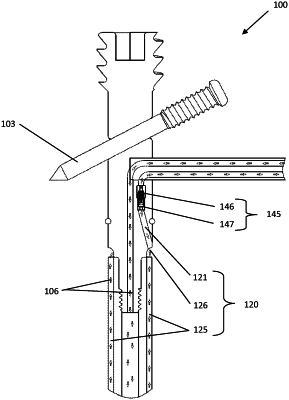| CPC A61B 17/72 (2013.01) [A61B 2017/00477 (2013.01); A61B 2017/561 (2013.01); A61M 5/16881 (2013.01)] | 20 Claims |

|
1. An intramedullary nail for the application of a pharmaceutical fluid, comprising
a fluid-conducting first conduit that extends axially within the intramedullary nail and is connectable to a first reservoir for the pharmaceutical fluid;
a plurality of lead-throughs that connect the first conduit in a fluid-conducting manner to an outer surface of the intramedullary nail; and
a fluid-conducting second conduit that connects the outer surface to a second reservoir and is configured to convey the pharmaceutical fluid between the first reservoir and the second reservoir, wherein the first conduit comprises a first connector for the fluid-conducting connection to the first reservoir, and the second conduit comprises a plurality of axially extending grooves that extend in and axially along the outer surface such that the plurality of grooves extend at least partially along and parallel to a longitudinal axis of the intramedullary nail and a second connector for the fluid-conducting connection to the second reservoir, wherein the first connector and the second connector are arranged at a first end of the intramedullary nail,
wherein the intramedullary nail has the same number of lead-throughs as the plurality of grooves, wherein one groove is in each case interconnected in a fluid conducting manner to a respective lead-through, and the lead-throughs are arranged at a second end of the intramedullary nail opposite to the first end, and
wherein the second conduit is configured and arranged to discharge the pharmaceutical fluid from the outer surface of the intramedullary nail at the first end of the intramedullary nail.
|